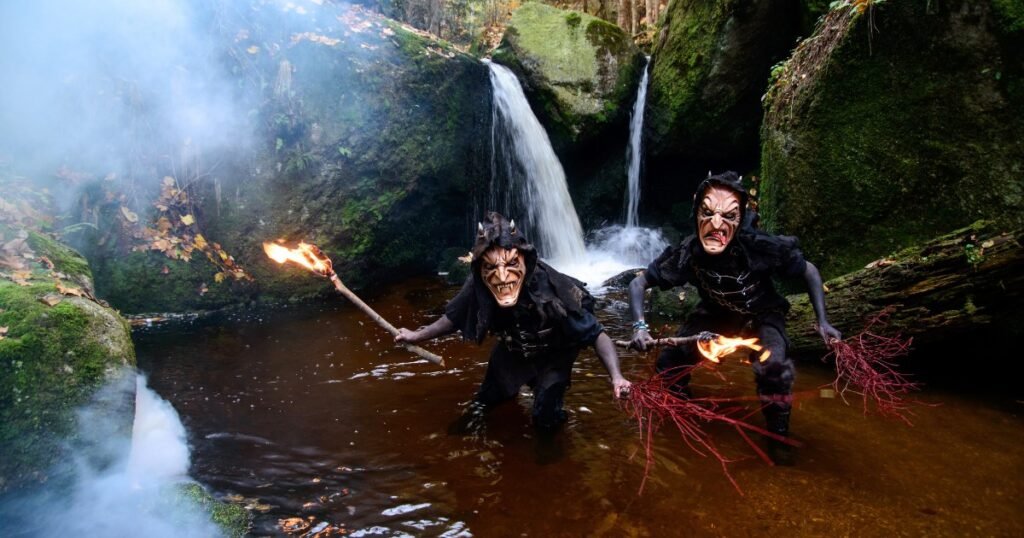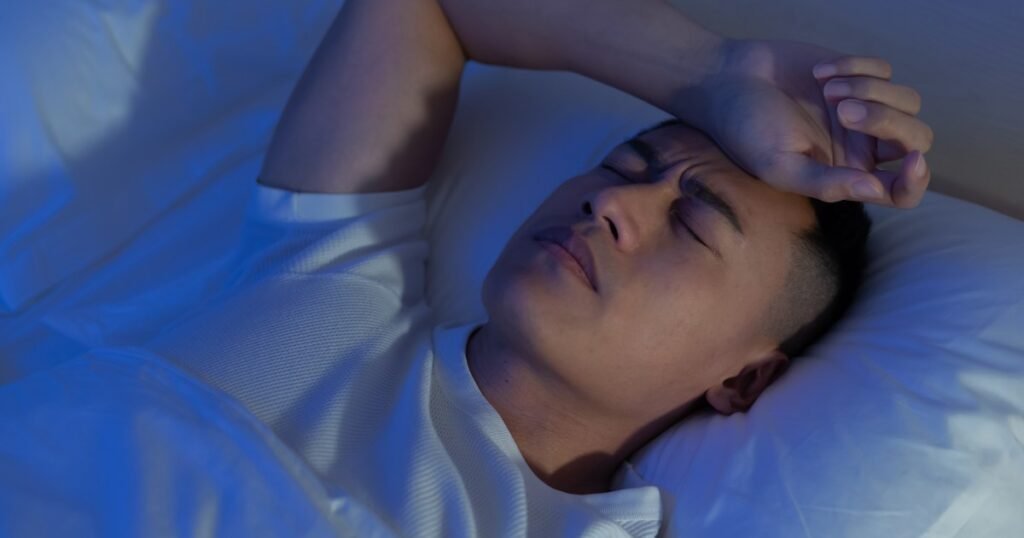Terror. Dread. Paralysis. These are just a few words that come to mind when one thinks of the infamous sleep paralysis demon. An eerie phenomenon that leaves its victims trapped in their bodies, unable to move or scream, while experiencing vivid and often horrifying hallucinations. It’s a chilling experience that has plagued countless individuals throughout history, transcending cultures and continents. But what exactly is a sleep paralysis demon? How does it manifest itself? And most importantly, how can we end this spine-chilling nightmare? Join us as we are jumping into the dark depths of sleep paralysis and uncover the secrets behind these haunting entities!
What is a Sleep Paralysis Demon?
Picture this: You wake up in the dead of night, your body frozen and unable to move. You try to scream, but you hear no sounds from your vocal cards and find your lips attached. Your heart races and a sense of impending doom washes over you. And then, out of the darkness emerges a figure – twisted and evil. This is the sleep paralysis demon.
Sleep paralysis demon is when individuals find themselves temporarily paralyzed upon waking up or falling asleep. It is often accompanied by vivid hallucinations that can range from unsettling to downright terrifying. These demons take on various forms across different cultures and personal experiences. Still, they are universally characterized by their ability to induce fear and helplessness.
While science has shed some light on the physiological aspects behind sleep paralysis (such as disrupted REM sleep cycles), it fails to explain why these hallucinations often manifest as dark entities or monsters. Some theories suggest that our deepest fears materialize during these episodes. In contrast, others attribute it to cultural influences or even supernatural forces.
Regardless of its origins, one thing remains clear – encountering a sleep paralysis demon can be an incredibly distressing experience.
Sleep Paralysis Demon depiction
Sleep paralysis demon depiction varies across different cultures and individuals. Many people who experience sleep paralysis describe a dark, shadowy figure lurking in their room or sitting on their chest. This entity is often described as having glowing red eyes, long claws, and a sinister aura.
Sometimes, the sleep paralysis demon takes on the form of a creepy creature or an unfamiliar face that instills fear and dread. Some believe these entities are evil spirits or supernatural beings that have come to torment them during their vulnerable sleep paralysis.
It’s important to note that these depictions vary subtly from person to person. The appearance of a sleep paralysis demon may be influenced by personal beliefs, cultural influences, and even individual fears and anxieties.
The vividness of the hallucinations experienced during sleep paralysis can make it difficult for individuals to differentiate between reality and fantasy. These terrifying visions can feel incredibly real, leading to intense panic and terror.
While there is no scientific evidence supporting the existence of actual demons or supernatural entities involved in sleep paralysis experiences, it does not diminish the real fear and distress felt by those who go through these episodes. Sleep paralysis demons continue to captivate our imaginations with their chilling presence during this peculiar phenomenon.
Paralysis
Paralysis is a phenomenon that can be profoundly unsettling and scary. It refers to the temporary loss of muscle control, rendering individuals unable to move or speak while fully conscious. In the context of sleep paralysis, this experience becomes even more distressing as it often occurs upon awakening or falling asleep.
During a paralytic episode, individuals may feel intense pressure on their chest and struggle to breathe. This sensation can exacerbate feelings of fear and anxiety, leading to a heightened sense of vulnerability.
Despite being physically immobilized during paralysis, many people report vivid hallucinations that intensify their unease. These hallucinations can take various forms, but one common depiction is the presence of a “sleep paralysis demon.” Often described as evil entities lurking in the room, these demons evoke terror and are associated with nightmares.

The causes behind sleep paralysis demons remain unclear. However, research suggests they may be linked to disruptions in normal sleep cycles or irregularities in brain chemistry. Stress and anxiety have also been identified as potential triggers for episodes.
Sleep disorders such as narcolepsy and insomnia are commonly associated with sleep paralysis and hallucinations. Other factors like sleep deprivation, sleeping on your back (supine position), and certain medications can increase the likelihood of experiencing these phenomena.
The concept of sleep paralysis demons has been ingrained in cultures worldwide for centuries. From ancient folklore to modern urban legends, stories abound about malevolent spirits haunting those trapped within this state.
To end an episode of sleep paralysis quickly, try focusing on small body movements like wiggling your toes or fingers before attempting larger ones like sitting up or moving your head from side to side, and gradually regain complete control over your body.
Hallucinations
Hallucinations during sleep paralysis can be a genuinely terrifying experience. When you cannot move, with your mind fully awake, and witnessing vivid and often disturbing images or sounds, it’s no wonder many people believe evil entities are visiting them.
During an episode of sleep paralysis, hallucinations can take on various forms. Some may see shadowy figures lurking in the corners of their room. In contrast, others report seeing grotesque creatures sitting on their chests or whispering into their ears. These hallucinations can feel genuine and intense, heightening feelings of fear and helplessness.
The exact cause of these hallucinations is still not fully understood. However, researchers suggest they may result from disruptions in the brain’s sleep-wake cycles. The brain enters a state between wakefulness and REM sleep during episodes of sleep paralysis, leading to mixed signals that manifest as visual or auditory hallucinations.

It’s important to note that not all cases of sleep paralysis involve horrifying hallucinations. Some individuals may only experience a sense of pressure on their chest or have difficulty breathing without any accompanying visuals or sounds.
While it may be tempting to attribute these experiences to supernatural beings or demons from folklore, science offers more rational explanations for this phenomenon. Understanding the biological processes behind sleep paralysis can help alleviate some fears associated with these episodes.
To end an episode of sleep paralysis when confronted with frightening hallucinations, experts recommend focusing on trying to move one small muscle at a time until the entire movement is regained. Additionally, learning relaxation techniques like deep breathing exercises can calm both the mind and body during these distressing moments.
To prevent future episodes altogether, maintaining good sleeping habits is crucial. This includes sticking to regular bedtimes and wake-up times, creating a comfortable bedroom environment conducive to quality rest, avoiding stimulants such as caffeine before bedtime, and practicing stress-reduction techniques like meditation or yoga.
What Causes a Sleep Paralysis Demon?
Sleep paralysis demons have long been the subject of fascination and fear. Many people who experience sleep paralysis report seeing terrifying hallucinations, often in the form of demonic figures. But what exactly causes these unsettling experiences?
Scientists believe that sleep paralysis occurs when there is a disruption in the transition between different stages of sleep. During REM (rapid eye movement) sleep, our brain is highly active, and vivid dreams occur. Our muscles become temporarily paralyzed to prevent us from acting out our dreams.
However, sometimes this paralysis persists even as we wake up or begin to regain consciousness. This can lead to feelings of immobility and terror as our mind becomes aware while our body remains immobilized.

The exact cause of sleep paralysis demons is still not fully understood, but several factors may contribute to their occurrence. Sleep deprivation, irregular sleeping patterns, stress, and anxiety are all thought to increase the likelihood of experiencing sleep paralysis episodes.
Certain medical conditions, such as narcolepsy or other sleep disorders, may also be associated with an increased risk of experiencing these phenomena.
While the exact cause may vary from person to person, it is clear that disruptions in standard sleep patterns play a significant role in triggering episodes of sleep paralysis and giving rise to those eerie encounters with shadowy entities known as “sleep paralysis demons.”
Conditions Associated With Sleep Paralysis and Hallucinations
1. Sleep Disorders: Several sleep disorders are linked to sleep paralysis, including narcolepsy, a condition characterized by excessive daytime sleepiness and sudden muscle weakness or loss of control. People with narcolepsy often experience episodes of sleep paralysis.
2. Insomnia: Lack of quality sleep can increase the likelihood of experiencing sleep paralysis. Chronic insomnia disrupts the typical patterns of rapid eye movements, and this phenomenon is called REM, which usually occurs when most of the dreams come together.

3. Anxiety and Stress: High anxiety and stress levels can contribute to sleep paralysis episodes. The body’s heightened state during periods of stress may disturb regular sleeping patterns and lead to more frequent experiences with paralysis.
4. Sleep Deprivation: Not enough restful sleep can also trigger episodes. It’s essential to prioritize good sleeping habits and ensure adequate uninterrupted slumber each night.

5. Substance Use: Certain substances like alcohol or drugs can interfere with normal brain function during REM sleep, increasing the likelihood of experiencing hallucinations or paralysis upon waking up.
Remember that these conditions are not exclusive causes but factors that may contribute to the occurrence or frequency of sleep.
Cultural Depictions of Sleep Demons
Throughout history and across different cultures, sleep demons have been featured in folklore, mythology, and art. These depictions vary widely, reflecting the diverse beliefs and fears surrounding this phenomenon.
In some cultures, sleep demons are portrayed as evil spirits or supernatural creatures that visit individuals during episodes of sleep paralysis. They are often described as shadowy figures with glowing eyes or grotesque features.
How to prevent Sleep Paralysis Demon
1. Establish a Consistent Sleep Routine: One of the key ways to prevent sleep paralysis is by maintaining a consistent sleep routine. Your body’s internal clock may be regulated by going to bed and getting up simultaneously daily.
2. Create a Calm Sleeping Environment: Your bedroom should be a sanctuary for restful sleep. Keep it calm, dark, and quiet to promote relaxation. Try to use blackout curtains and prefer to use white noise generators.
3. Reduce Stress Levels: Stress can often trigger episodes of sleep paralysisFind healthy ways to manage stress, such as practicing mindfulness, exercising regularly, or seeking professional help.
Read More : knowledgeglaxy.com
4. Avoid Stimulants before bed: stopping caffeine intake before several hours before bedtime can improve the sleep-wake cycle by having an uninterrupted slumber.
5. Improve Sleep Hygiene Practices: Good sleep hygiene habits can significantly contribute to preventing sleep paralysis incidents. This includes avoiding heavy meals, using screens, and practicing a relaxing pre-sleep routine that helps signal your body it’s time for rest.
1. What is Sleep Paralysis?
It’s a phenomenon that can be described as when individuals find themselves temporarily paralyzed upon waking up or falling asleep. It can be accompanied by hallucinations and a feeling of pressure on the chest, which can often be distressing.
2. Is sleep paralysis dangerous?
While sleep paralysis is not physically harmful, it can be an incredibly frightening experience for those who go through it. The feeling of being unable to move or speak, combined with hallucinations, can cause significant anxiety and fear.
3. Are demons real during sleep paralysis?
The perception of “demons” during sleep paralysis episodes is a cultural interpretation rather than a reality. These hallucinations are often described as shadowy figures or menacing entities. Still, they are purely creations of the mind and not supernatural beings.
4. Can you prevent sleep paralysis?
Although there isn’t one foolproof method for preventing sleep paralysis, there are some steps you can take to reduce its occurrence:
– Maintaining good sleeping habits: Stick to regular sleeping patterns and ensure you get enough quality rest.
– Managing stress levels: Stress has been linked to an increased frequency of sleep paralysis episodes.
– Creating a comfortable sleeping environment: Make sure your bedroom is dark, quiet, and free from distractions.
– Avoiding specific triggers: Some people find that avoiding caffeine before bed or sleeping in specific positions helps reduce the likelihood of experiencing sleep paralysis.
5. When should I seek medical help for my sleep experiences?
Suppose you frequently experience episodes of sleep paralysis that significantly disrupt your daily life or cause excessive distress. In that case, consulting with a healthcare professional specializing in sleep disorders may be beneficial.






